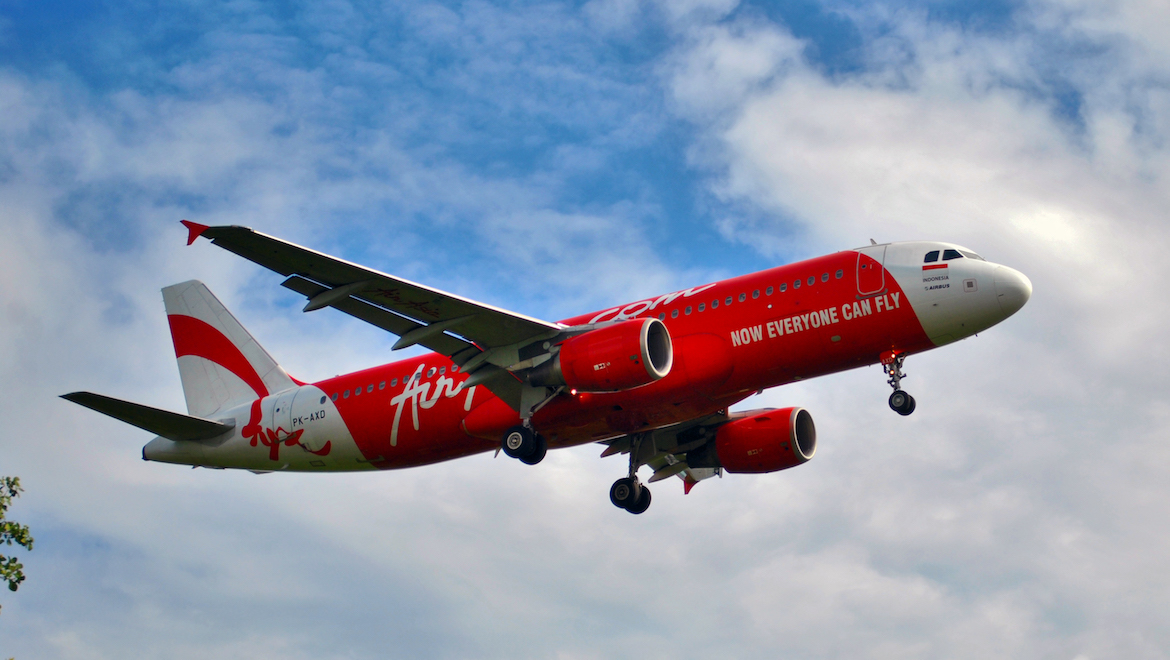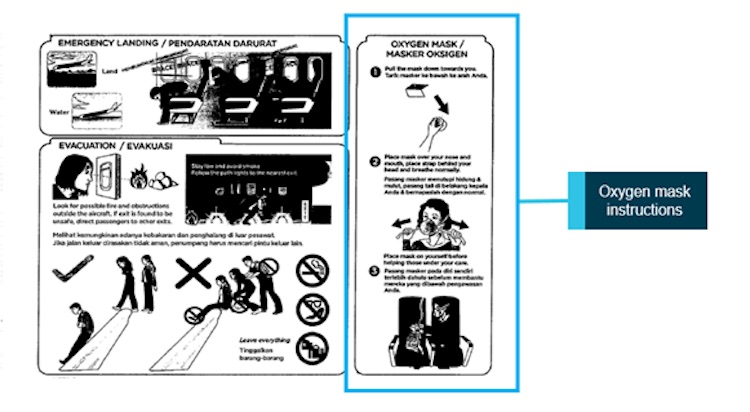
The Australian Transport Safety Bureau (ATSB) has called on AirAsia Indonesia to review its pre-flight briefing and safety information card after unfamiliarity with the oxygen masks caused passenger confusion on a recent flight.
The safety recommendation was included in the ATSB’s final report published on Wednesday into an October 15 2017 incident on board an AirAsia Indonesia Airbus A320 PK-AXD flying from Perth to Denpasar.
Shortly after takeoff, the flight crew requested permission from air traffic control to conduct an emergency descent in response to a master warning for a high cabin altitude.
The captain then informed the 146 passengers and four cabin crew of the emergency descent and deployed the oxygen masks.
“However, several units either did not deploy, or deployed but did not provide oxygen,” the ATSB final report said.”Consequently, several passengers moved around the cabin to secure a spare oxygen mask.”
“As passengers were moving around while the seat belt sign was illuminated, the cabin crew shouted commands such as ‘BRACE’, ‘GET DOWN’ and ‘CRASH POSITION’.
“This probably increased the level of confusion and panic amongst some passengers.”
The aircraft landed safely.
The ATSB final report said one of the cabin crew members (P1) put on an oxygen mask and announced three times to the passengers “GRAB MASK, FASTEN SEATBELT, BREATHE NORMALLY” and used hand signals to demonstrate the instructions.

Meanwhile, another cabin crew member (P4) at the rear of the aircraft had initially announced “SIT DOWN”, while waiting for the masks to deploy.
When the masks deployed, two cabin crew members (P2 and P3) announced the instructions “GRAB MASK, FASTEN SEATBELT, BREATHE NORMALLY” and demonstrated the actions after noticing some passengers were unsure what to do.
Then, after arriving in Perth, cabin crew member P1 noted several passengers had donned their life jackets.
“During disembarkation she then received several passenger reports of the cabin crew members at the rear panicking, shouting and alarming the children,” the ATSB final report said.
“When P1 followed up with those members, P3 reported that she may have appeared to be panicking because she felt the oxygen mask was not providing sufficient oxygen.
“P2 and P3, at the rear of the cabin, reported that they were shouting as this was the procedure. P3 reported that she shouted at a passenger who stood up during the descent due to the risk of a fall.”
The ATSB said its survey of passengers on the flight found about 53 per cent of those on board were unsure if oxygen was flowing from their oxygen masks.
Further, several passengers also expressed a misunderstanding of how the equipment was operated.
Meanwhile, the ATSB’s inspection of the cabin also found a number of seats where there were issues with the oxygen equipment, as shown below.

Finally, the ATSB final report noted the pre-flight safety briefing and safety information card did not include a clear instruction on how to activate the flow of oxygen from the passenger oxygen masks and that the bag may not inflate when oxygen was flowing.

“The ATSB recommends that AirAsia Indonesia take further action to review its current passenger pre-flight safety briefing and safety information card to ensure passengers are provided with clear instruction on how to activate the flow of oxygen from the passenger oxygen masks and that the bag may not inflate when oxygen is flowing,” the ATSB final report said.
AirAsia Indonesia’s response to the safety recommendation that was included in the ATSB final report said the low-cost carrier (LCC) followed Indonesian regulations, adding that it would “consider” including the requirements in its safety demonstration announcements.
ATSB transport safety director Dr Stuart Godley said the cabin crew’s ability to recall and use appropriate standard commands was an important part of managing abnormal passenger responses.
“Passengers generally responded well when appropriate commands were used, but incorrect commands resulted in some confusion and panic,” Dr Godley said in a statement.
Further, Dr Godley said information highlighting that oxygen was flowing through the mask even though the bag may not inflate would improve passengers’ knowledge and reduce anxiety and their susceptibility to a hypoxia-related event.
“Cabin crew emergency procedures training that includes role-playing of the full range of expected passenger behaviour, including panic and confusion, can better prepare cabin crew when exposed to more complex real-world scenarios,” Dr Godley said.
An inspection of the aircraft after landing found an “intermittent rare fault with cabin pressure controller 1 circuit board, which resulted in incorrect control of the outflow valve”.
This had led to the over-pressurisation of the aircraft cabin and activation of the cabin safety valve, the ATSB final report said.
“Following the activation of the safety valve(s), several warnings of excess cabin altitude were generated, which ultimately resulted in the flight crew conducting the emergency descent procedure,” the ATSB final report said.
“The ATSB found that the operator had reviewed and elected not to incorporate the manufacturers recommended, but not mandatory, improvements to the pressurisation system.
“The improvements were communicated to the airline by service bulletins. Incorporating the bulletins would have likely prevented the emergency descent incident.”
The full report can be read on the ATSB website.
















Dane
says:Was there investigation into whether or not the passengers listened to safety briefing? Most people these days seem to ignore the flight attendants and choose to play with their phones with headphones in much to the ire of the staff giving the brief.
Deepspa
says:Agree Dane. Most people dont pay attention to the safety briefing, nor read the safety card. And even if they did, there would still be a good proportion of passengers that would either get it wrong or freeze and not follow instructions at all. How useful the ATSBs recommendations will be is very questionable., but I guess they need to point the finger at something.